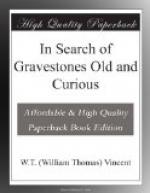[Footnote 11: The Muckross stone (No. 1) was overgrown with ivy which quite covered up the inscription, but its date was probably about 1750. Of the two from Queenstown, No. 2 is to Mary Gammell, 1793, aged 53; and No. 3 to Roger Brettridge, 1776, aged 63.]
[Illustration: Fig. 90. Bangor, Ireland.]
[Illustration: Fig. 91. Muckross and Queenstown.]
I leave to the ethnologists the task of accounting for these abnormal carvings in the South of Ireland, and associating them with the like productions of the same period in the South of England. Or perhaps I ought rather to excuse my insufficient researches, which, though spread over a broad area, are yet confined to but a few of the many spots available, and may very probably have passed by unexplored the fruitful fields. But, in the words of Professor Stephens, the apostle of Runic monuments, I claim for this work that it is “only a beginning, a breaking of the ice, a ground upon which others may build.” My pages are but “feelers groping out things and thoughts for further examination.”
CHAPTER XI.
Old gravestones in Scotland.
A very peculiar interest attaches to the old stones which survive in the burial-grounds of Scotland. Regarded generally they are of a description quite apart from the prevalent features of their English and Irish prototypes. Taking the same period as hitherto in limiting our purview of the subject, that is from the latter part of the seventeenth to the early part of the nineteenth century, it may perhaps be said that the Scottish headstones are tablets of Scottish history and registers of Scottish character during a long and memorable time. The one all-prevalent feature everywhere is indicative of the severe piety and self-sacrifice of an age and a people remarkable for one of the simplest professions of faith that has ever existed under the Christian dispensation. The rigid discipline, contempt for form, and sustained humility of the old Covenanters are written deeply in the modest stones which mark the green graves of their faithful dead during a period of fully two hundred years. The vainglory of a graven stone to exalt the virtues of imperfect men and women was to them a forbidden thing; the ostentation even of a name carved on a slab was at variance with doctrine; the cravings of a poor humanity to be remembered after death had to be satisfied with bare initials, and initials are all that were written on the gravestones in many thousands of cases, probably ninety per cent, of the whole, throughout the eighteenth century and approximate years. But the rule was not without its exceptions, often of novel and peculiar description. The skull and crossbone series, so common in the south, have no place in North Britain; while the symbol of the cross, so frequent in Ireland, is very rarely to be found in any shape whatever within the boundaries of a Scottish burial-place. I present four specimen types from the old chapel-yard at Inverness.




